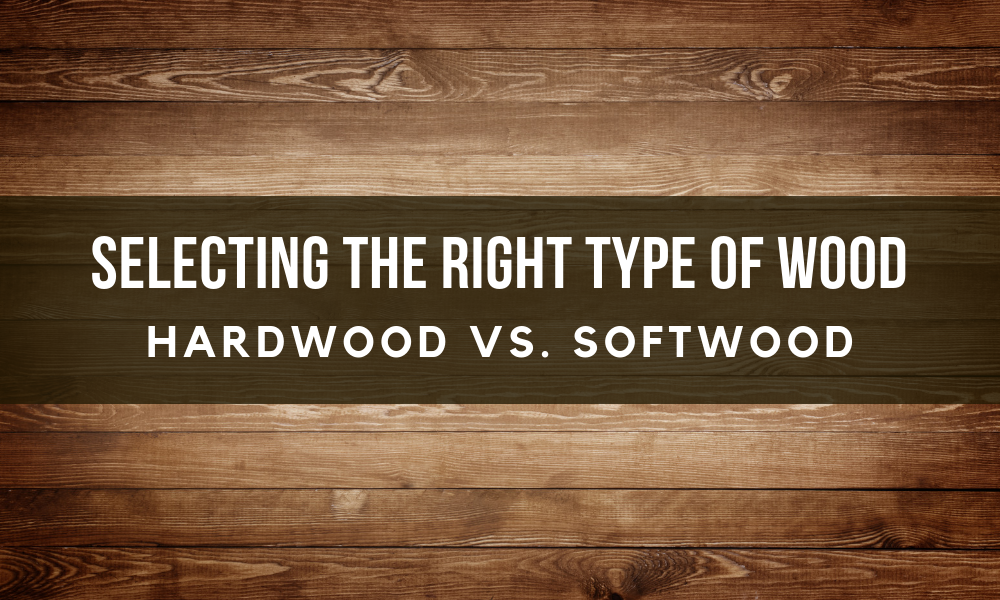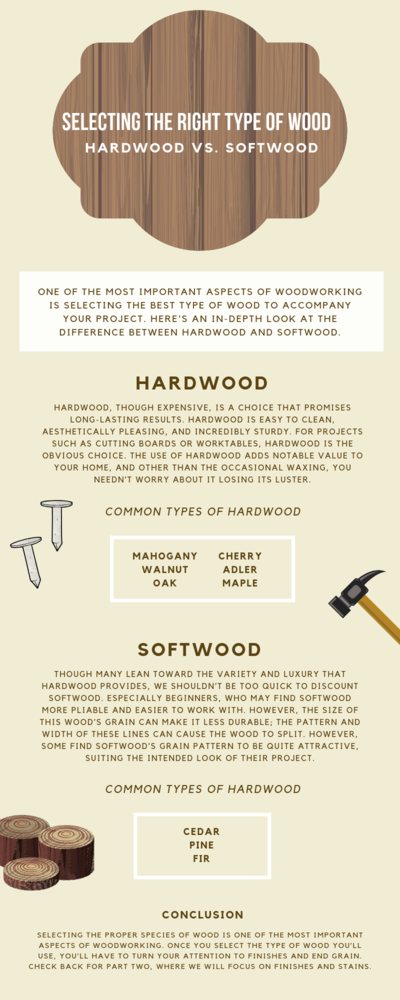Selecting the Right Type of Wood Pt 1: Hardwood vs. Softwood

One of the most important aspects of woodworking is selecting the best type of wood to accompany your project. This may seem like a daunting task for anyone new to the diverse world of woodworking. There are currently 60,065 identified tree species—a large enough number to make anyone’s head spin. However, no one is going to sift through several thousand types of trees to determine the option that works for them. Once you familiarize yourself with all aspects of
woodworking, the selection process becomes a matter of elimination.
Before anything else, you’ll decide whether you should use hardwood or softwood. A common misconception is that the difference between the two is their density. However, this isn’t always the case—the difference actually lies in the tree’s shedding pattern. Hardwood usually comes from a deciduous tree, which means that every year it loses its leaves. Softwood, however, comes from a conifer and stays evergreen throughout the year.
Having this knowledge is useful in identifying a species’ durability, but there’s a
lot more that goes into selecting the appropriate wood for your project. Below
we go a bit more in-depth regarding the difference between hardwood and
softwood and give a brief overview of types that woodworkers commonly use.
Hardwood
Hardwood, though more expensive, is a choice that promises long-lasting results. Hardwood is easy to clean, aesthetically pleasing, and incredibly sturdy. For projects such as cutting boards or worktables, hardwood is the obvious choice. The use of hardwood adds notable value to your home, and other than the occasional waxing, you needn’t worry about it losing its luster.
While being the obvious choice for many, hardwood can be difficult to work with. For anyone inexperienced, it can be difficult to cut and may not hold nails as well
as softwood. You want to be careful when using power tools on hardwood—take
your time. Mistakes can be costly, and it’s best to avoid them when possible. These same properties of hardness and higher density make hardwoods the ideal machine carving wood with the denser woods, such as maple and beech.
Heartwood Carving consistently utilizes this information, providing clients with the best results possible.
Part of the reason behind hardwood’s expense is its sustainability. It takes hardwood trees longer to grow, meaning they regenerate at a slower rate. Softwood, in comparison, has a notably faster growth rate and therefore provides a faster turnover.
For select furniture that you wish to last a lifetime, hardwood is the best option.
It can withstand wear and tear and is less likely to change shape according to
the seasons. When creating pieces that require a perfect fit, such as cabinetry
drawers, hardwood is the ideal option.
Common Types
of Hardwood
Mahogany:
This type of wood has a reputation for being desirable due to its stunning
color and longevity. It’s oftentimes used for furniture and floors as it provides a luxe look to any environment; some extremely skilled crafters may even use it to craft writing instruments. Though it requires patience, mahogany is known for being incredibly easy to work with. Although true Mahogany from Honduras is not readily available, other species from Africa—including Sapele and Khaya—are currently more common in North America.
Walnut:
More expensive than many hardwoods due to its limited quantities, walnut is an
incredibly sturdy wood with the ability to withstand a variety of elements.
It’s the heartwood—which is the wood in the center—that gives it the dark
chocolate color we associate with walnut. Many consider the white, creamy
colored sapwood in the outer growth rings less desirable and reduces yields. In
addition, due to the many branches on a walnut tree, this wood is likely to
boast a variety of knots, which many consider an attractive element in
woodworking. Woodworkers often use walnut in furniture making as no other North American wood carries the natural dark color. In order to create a symmetrical pattern with its knots, a woodworker can cut a piece of lumber vertically and place it side by side for consistency and a book-matched appearance. Walnut machine carves extremely well.
Oak: This is one of the most common types of wood by far, often referred to as the king of woods, and you most likely have some in your own home. There are a few different species, and how it looks will depend on if you purchase red or white
oak. Red Oak is quite grainy when stained, which may not be appealing to some,
but it’s extremely sturdy and decently priced. White Oak is water-resistant,
which makes it an ideal option for outdoor furniture and doors.
Cherry:
This attractive variety of wood comes in a diverse assortment of colors that
allows for convenient customization. Both durable and aesthetically-pleasing,
cherry is also a joy to work with. It has a medium density and reacts beautifully to hand and machine carving and woodworkers can select and stain it to match any room.
Alder: A clean wood, alder is an excellent choice for cabinetry and chairs. Due to its light finish, woodworkers can stain alder to replicate the look of other wood
species, most notably cherry, but including walnut and mahogany. Alder reacts
well to tools and can easily withstand nails and screws without fear of
splitting. Lauded for its workability and diversity, alder is the wood of
choice for many woodworkers. In the machine carving world alder is not always
the best choice as it has less density and therefore does not hold sharp peaks
and edges and can be fuzzy to clean and sand.
Maple:
This is another wood that’s praised for its variety. Unlike the two species
above however, maple is not easily stainable and so it is difficult to alter
its appearance to fit the woodworker’s preference through staining. It’s
beautiful grain pattern makes this wood unique and many are content to merely
sand it and leave it as-is. Maple is ideal for flooring, as it’s incredibly
dense and durable. Further, when machine carved you can shape it into designs
that are both stunning and clean because of the high density.
Softwood
Though many lean toward the variety and luxury that hardwood provides, we shouldn’t be too quick to discount softwood. Especially beginners, who may find softwood more pliable and easier to work with. However, the size of this wood’s grain can make it less durable; the pattern and width of these lines can cause the
wood to split. However, some find softwood’s grain pattern to be quite attractive, suiting the intended look of their project.
As stated above, softwood is simple to work with, and hobbyists appreciate it for its versatility. Putting aside the occasional lack of durability, it can be extremely forgiving. Many enjoy it for creating fine details in decorative woodwork. However, for machine carving, these same properties can make for a fragile carving with fuzzy grain that requires extra finishing and sanding to fully remove.
The combination of its fast growth rate, low density, and high production makes
softwood a cost-friendly option. And although it is less durable, softwood can
last for decades if properly cared for. If you choose the correct finish and
provide regular maintenance, you can get your money’s worth, plus more.
Common
Types of Softwood
Cedar: A lovely, light-colored wood with an attractive scent, woodworkers oftentimes use cedar for storage containers, including trunks, wardrobes, and gardening beds. Cedar is usually resistant to rotting, making it a popular option for outdoor use and attics. Although it’s fairly easy to work with, cedar is not very
structurally sound and does not always do well with fastening and can detach
from screws and nails over time.
Pine:
Oftentimes containing knots and irregular patterns, pine is a good option for
rustic themes. It also takes stain well, so you can really optimize a vintage
look if that’s what you’re going for. Due to its porosity, you want to make
sure that your pine furniture is well protected. A negative of pine is that it
can dispel sap and it isn’t the most durable option, as it is susceptible to
scratches and dents. For machine carving it is also not a very good choice as
the low density does not withstand the rigors of machining fine peaks and
edges.
Fir:
This softwood is one of the most inexpensive options, so anyone new to woodworking may want to try their hand at fir while they work through trial and error. It has a thin, straight grain that makes it useful for projects requiring
symmetry, such ask picnic tables and rocking chairs. Although Vertical Grain
Fir is part of the same family, it comes at a much higher cost due to the style
of the cut required to get create a parallel grain. This reduction in yield
pushes the costs for ‘VG” Fir much higher. Fir again as a softwood can be
machine carved but the results are mixed and a harder wood is preferred.
Conclusion
Selecting the proper species of wood is one of the most important aspects of woodworking, but it isn’t the only thing that you’ll need to decide on before you begin your project. Once you select the type of wood you’ll use, you’ll have to turn your attention to finishes and end grain. This blog is the first of a three-part
series in which we focus on all the aspects behind selecting the proper tools
for your project. Check back for part two, where we will focus on finishes and stains.

